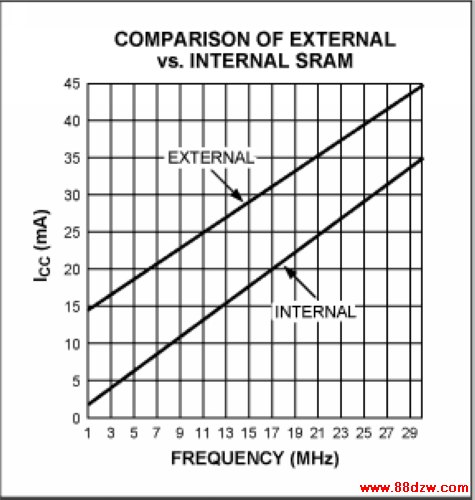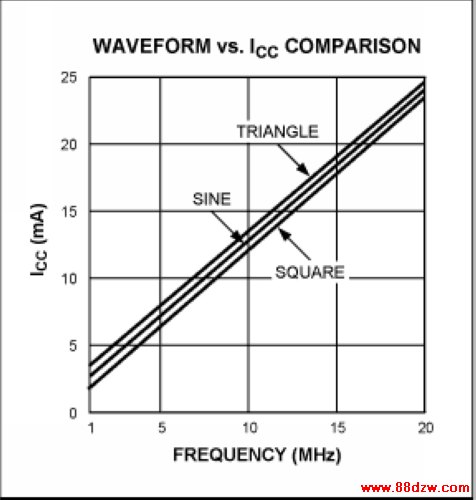Microcontrollers Improve Power
[09-13 17:03:33] 来源:http://www.88dzw.com 控制技术 阅读:8436次
文章摘要:Clock Source Another critical system component from a power standpoint is the clock source. Standard 8051 designs typically either excite an external quartz crystal with an internal oscillator amplifier or use an external crystal oscillator. If an external crystal oscillator is used, the waveform of
Microcontrollers Improve Power,标签:计算机控制技术,工厂电气控制技术,http://www.88dzw.comClock Source
Another critical system component from a power standpoint is the clock source. Standard 8051 designs typically either excite an external quartz crystal with an internal oscillator amplifier or use an external crystal oscillator. If an external crystal oscillator is used, the waveform of the clock can affect power consumption. The input stage of the XTAL1 pin, used to drive external clock signals into an 8051, typically employs complementary drivers. As the input clock transitions between high and low, the drivers will momentarily both be on, causing a significant current rush. With a square wave, the transition between high and low states is almost instantaneous, and the time in which both devices are on is minimized. A waveform with a slower rise and fall time, such as a sine or triangle wave, will take longer to complete the transition and will spend more time with both drivers on. This will increase current and power consumption.
Figure 4. Eliminating external SRAM and latch saves power.
Figure 5 shows the relationship of current consumption to the waveform shape. The clock source was a programmable waveform generator, with the ability to output sine, triangle, or square waves. The current consumption shown is an average of four devices, both traditional and high-speed core. The comparison shows that current consumption is directly proportional to the rise (and fall) time of the clock waveform. The triangle wave has the lowest slope and the square wave the highest slope. The square wave averages 0.75mA less than the triangle wave. This implies that current consumption in external clock oscillator designs can be reduced by using oscillators with fast rise and fall times. This becomes even more important at lower frequencies, when the device spends more time in transition.

Figure 5. Oscillator waveforms with sharper edges reduce power consumption.
Some 8051 derivatives incorporate an on-chip internal ring oscillator. This is typically a chain of inverters that propagates a pulse around it. This provides an internal clock source of approximately 2MHz to 4MHz, capable of operating the device. Because it does not require the use of a crystal, it is a very-low-power clock source. Characterization of a DS87C520 high-speed microcontroller shows that operation from the ring oscillator can deliver performance comparable to a 7MHz 8051 at approximately 3.6mA. Although ring oscillators do not exhibit the stability of piezoelectric crystals, their low power and negligible power-on delay make them a significant factor in a power management scheme.
Clock Management
As mentioned previously, the operating frequency of the microcontroller is the single largest factor affecting the power consumption of the device. Although the system clock frequency is primarily a hardware function, the 8051 has the ability to exercise limited control over it. These methods rely on slowing or halting the internal operating frequency of all or part of the device. Traditional 8051 architecture has used two clock control modes: Idle and Stop.上一页 [1] [2] [3] [4] [5] [6] [7] [8] [9] 下一页
Tag:控制技术,计算机控制技术,工厂电气控制技术,控制技术
《Microcontrollers Improve Power》相关文章
- › MICRF501 300~500 MHz收发器
- › MICRF500 FSK l000~700 MHz收发器
- › Microcontrollers Improve Power
- › Micronas最新控制IC优化平板显示器图像质量
- › Micronas 推出FRC 94xyM全高清帧率转换IC
- › Microchip推出新型低成本数字信号控制器系列
- 在百度中搜索相关文章:Microcontrollers Improve Power
- 在谷歌中搜索相关文章:Microcontrollers Improve Power
- 在soso中搜索相关文章:Microcontrollers Improve Power
- 在搜狗中搜索相关文章:Microcontrollers Improve Power
分类导航
最新更新




 当前位置:
当前位置: